
There are over 400 occurrences of the word “joy” in the Bible, most of them referring to what awaits those who become close to God. So why do icons – portraits of people who have been received by Christ into Heaven – show the Saints looking sombre?
It is certainly the case that there is a tradition within Orthodoxy of a continual grieving over our sins that leads to purification. Indeed, St James states it quite clearly in his epistle:
Submit yourselves therefore to God. Resist the devil, and he will flee from you. Draw near to God, and he will draw near to you. Cleanse your hands, you sinners; and purify your hearts, you double minded. Be afflicted, and mourn, and weep: let your laughter be turned to mourning, and your joy to heaviness. Humble yourselves in the sight of the Lord, and he shall lift you up. (James 4:7-10)
There are numerous examples of ascetic Saints who pursued this path of mourning, both for their own sins and the sins of others, being granted the gift of tears. Saint Lazarus of Bethany, who was raised from the dead by Christ, was famous for not smiling in all the thirty years of his life lived after the joyous Resurrection of Christ. The twentieth-century Saint, Silouan the Athonite (pictured above), wrote: “The Lord Jesus Christ, Son of God, accords the monk the love of the Holy spirit, and because of this love his heart continually sorrows over people, because not all will be saved.” (emphasis mine).
 |
|
St Anthony the Great |
Yet for all this, there is no suggestion from the Holy Fathers that smiling or laughter is somehow sinful, nor that the Saints themselves did not smile. A story about the father of monasticism, Anthony the Great, relates how a hunter discovered him laughing with the other monks. The hunter was shocked to see such behaviour from the great ascetic, but St Anthony showed by the example of the hunter’s bow that it was sometimes necessary for the monks to relax in their labours, so that they do not “snap” under the strain. It is also true that despite injunctions from St James to mourn over our sins, the ultimate aim is for the Lord to “lift us up” to heavenly things. With this undoubtedly comes “joy”.
The question, then, becomes: what is this joy that we Christians are promised? Monk Moses the Athonite writes about what true joy is not: “Some think that joy will be found in unbridled fun, shameless revels, the overnight hunt for pleasure, the celebration of drunkenness, the drunkenness of luxury, extravagance and indulgence. If one could photograph the depths of the hearts of these patrons of so-called entertainment centers, we would observe an abyss of pain, desolation, coldness and hard loneliness. Joy is not sold in any store nor bought with little or much money….. They return from secular entertainment jaded, downcast, sad, more alone. Some think that all rich people are quite happy. This is a big lie, which often is confirmed by the same”.
True joy is something that comes from God and is therefore eternal. Fleeting pleasures are, by definition, temporary and do not bring true happiness. The smile is a reflection of fleeting happiness, because it too is temporary. There are many examples of “good” smiles – the pure smile of a child, the loving smile of a mother, the sincere smile of a friend – but nevertheless the smile is something belonging to worldly life. No worse, nor less useful, than eating or sleeping, smiling is along with those things something that is done while we are in the flesh, but something not required once we are purified and worthy of Heaven.
Maximus the Confessor summarizes the state of those who complete this purification: “The rewards for the toils of virtue are dispassion and spiritual knowledge. For these are the mediators of the kingdom of heaven, just as passions and ignorance are the mediators of eternal punishment”.

And according to the same saint: “Dispassion is a peaceful condition of the soul.”
It is this “peaceful condition” that is communicated in the countenance of Saints in icons. It is far above the fleeting happiness of the world and the ceasing of sorrow over sins, and is what can truly be called joy. It is the transfigured, revealed, reality of the blessed, joyful, heavenly state. It is a reflection of the peace Christ promised to His disciples; the peace which belongs to Christ Himself (John 14:27).
This heavenly dispassion is present in all well-painted icons. Emotion can be depicted in bodily gestures, or in the colours used, or especially in the eyes (again, see the Epitaphios with the mourners’ tear-tracks).
Yet through all this the general countenance of Christ or His Saints remains calm, clear, peaceful and dispassionate.

Despite all that is written above you may still not be convinced that the Christ and His Saints look all that happy in icons of them. Well, there is an extra point to consider. Icons depict the heavenly reality of God, His Holy Mother, and the Saints, and effectively present them to us. When we stand before an icon of Christ, for example, and see Him “looking at us”, we are to be reminded that Christ is always present and looking at us. The clairvoyance of Jesus is shared by His Mother and the Saints too. Given that they all know our sins, sorrows, and frailties, why should we expect them to look happy? To see any sadness in their gaze is a reminder of their love for us and should act as a spur to our own repentance and sorrow over sin. Lord have mercy!




